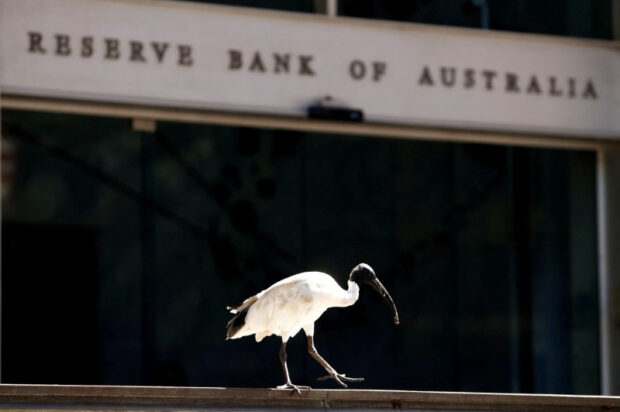Australia’s central bank holds rates, waters down tightening bias

An ibis bird perches next to the Reserve Bank of Australia headquarters in central Sydney, Australia Feb 6, 2018. REUTERS/Daniel Munoz/File photo
SYDNEY — Australia’s central bank held interest rates steady on Tuesday and watered down its tightening bias, signaling greater confidence that inflation is moving back to its target as the economy slows.
Wrapping up its two-day March policy meeting, the Reserve Bank of Australia (RBA) kept rates at a 12-year high of 4.35 percent for a third straight meeting, and said it was not ruling anything in or out on policy.
Markets had wagered heavily on a steady outcome given inflation has held at two-year lows and economic growth slowed to a crawl.
“The path of interest rates that will best ensure that inflation returns to target in a reasonable timeframe remains uncertain and the Board is not ruling anything in or out,” said the RBA Board in a statement.
That compared with the previous phrasing that “a further increase in interest rates cannot be ruled out”.
READ: Australia’s January inflation holds at two-year low
Governor Michelle Bullock declined to say whether policy has shifted to neutral at her post meeting briefing, saying risks are “finely balanced”, and pushed back immediate rate cuts.
Aussie dollar dips
“All we can do is tread carefully and be prepared to act if we see the risk moving in one direction or the other,” said Bullock.
“We have to be prepared to watch data…. what it’s telling us where things are heading and if that’s changing our assessment and that’s going to drive potential changes.”
The Australian dollar eased 0.6 percent to $0.6518. Three-year bond yields fell 7 basis points to 3.687 percent and markets are now pricing in a total easing of 43 basis points this year, up from 37 bps before the RBA statement.
“We expect the RBA to remove the last remnants of its tightening bias at the June board meeting, before cutting rates by 25bp in August before a second cut in November, which will see the cash rate end the year at 3.85 percent,” said Tony Sycamore, an analyst at IG.
Commonwealth Bank of Australia and Goldman Sachs said the RBA removed its tightening bias and shifted to a neutral stance, while ANZ said it was more a weakening in bias, and National Australia Bank said the changes in tone were “stylistic tweaks”.
Inflation at two-year low
Data over the past six weeks suggests the previous policy tightening – with the benchmark rate up 425 basis points since May 2022 – is working well to constrain demand.
READ: Australia’s central bank holds rates as inflation cools
Inflation held at a two-year low of 3.4 percent in January, the economy grew by a tepid 0.2 percent last quarter as household consumption flatlined and the jobless rate crept up to 4.1 percent, faster than the central bank had forecast. The RBA targets an inflation rate of between 2 percent and 3 percent.
Even though domestic data have largely been on the soft side, markets have scaled back bets for the RBA easing this year, thanks to a shift in expectations for U.S. rates due to sticky inflation there. The timing for the first Federal Reserve rate cut has now been pushed out to June, and maybe even July.
Also on Tuesday, the Bank of Japan ended eight years of negative interest rates and other remnants of its unorthodox monetary policy, a historic shift away from decades of massive monetary stimulus.